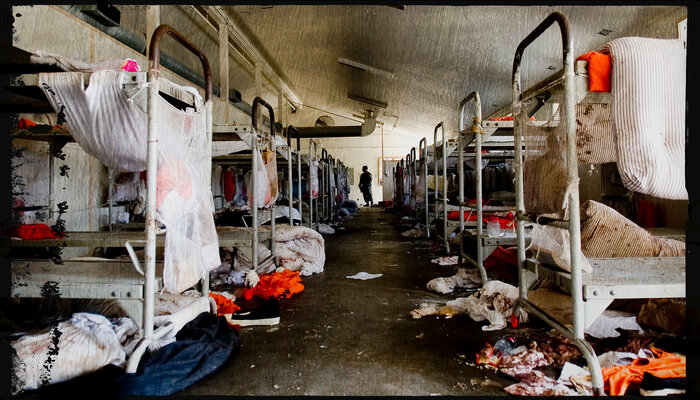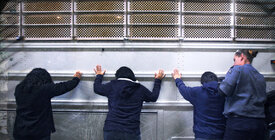This essay is part of the Brennan Center’s series examining the punitive excess that has come to define America’s criminal legal system.
Imagine one of those dystopian movies in which some character inhabits a world marked by dehumanization and a continual state of fear, neglect, and physical violence — The Hunger Games, for instance, or Mad Max. Now imagine that the people living in those worlds return to ours to become your neighbors. After such brutal traumatization, is it any wonder that they might struggle to obtain stable housing or employment, manage mental illness, deal with conflict, or become a better spouse or parent?
This is no fantasy world. American prisons cage millions of human beings in conditions similar to those movies. Of the more than 1.5 million people incarcerated in American prisons in 2019, more than 95 percent will be released back into the community at some point, at a rate of around 600,000 people each year. Given those numbers, we should ensure that those in our prisons come home better off, not worse — for their sake, but for society’s as well.
Yet our prisons fail miserably at preparing people for a law-abiding and successful life after release. A long-term study of recidivism rates of people released from state prisons from 2005 to 2014 found that 68 percent were arrested within three years and 83 percent were arrested within nine years following their release. And evidence confirms the great irony of our American criminal justice system: the longer someone spends in “corrections,” the less likely they are to stay out of jail or prison after their release. The data tells us that people are spending more time in prisons and the longest prison terms just keep getting longer, and thus our system of mass incarceration all but assures high rates of recidivism.
It is not difficult to understand why our prisons largely fail at preparing people to return to society successfully. American prisons are dangerous. Most are understaffed and overpopulated. Because of inadequate supervision, people in our prisons are exposed to incredible amounts of violence, including sexual violence. As just one example, in 2019 the Department of Justice’s Civil Rights Division concluded that Alabama’s prison system failed to protect prisoners from astounding levels of homicide and rape. In a single week, there were four stabbings (one that involved a death), three sexual assaults, several beatings, and one person’s bed set on fire as he slept.
Our prisons are so violent that they meaningfully impact the rehabilitation efforts for those inside them. There is an ever-present fear of violence in our gladiator-style prisons, where people have no protection from it. Incarcerated people who frequently witness violence and feel helpless to protect against it can experience post-traumatic stress symptoms — such as anxiety, depression, paranoia, and difficulty with emotional regulation — that last years after their release from custody. Because escalating conflict is the norm for those serving time in American prisons (often provoking violence as a self-defense mechanism), when they face conflict after being released, they are ill-equipped to handle it in a productive way. If the number of people impacted by prison violence was small, this situation would still be unjust and inhumane. But when more than 113 million Americans have had a close family member in jail or prison, the social costs can be cataclysmic.
Part of the reason our prisons are so violent is due to the idleness that occurs in them. As prison systems expanded over the last four decades, many states rejected the role of rehabilitation and reduced the number of available rehabilitation and educational programs. In Florida, which is the nation’s third largest prison system, there are virtually no education programs for prisoners, even though research shows that those programs reduce violence in prison and the recidivism rate for those released from prison.
It is not just the violence that is harmful. How American prisons are designed negatively impacts the ability of people to be self-reliant after their release. Prisons create social isolation by taking people from their communities and placing them behind razor wire, in locked cages. Through strict authoritarianism, rules, and control, prisons lessen personal autonomy and increase institutional dependence. This ensures that people learn to rely upon the free room and board only a prison can offer, thus rendering them less able to cope with economic demands upon release.
The location of our prisons also causes harm. Many prisons are located far away from cities and hundreds of miles from prisoners’ families. Consequently, family relationships deteriorate, impacting both prisoners and their loved ones. Just this past Mother’s Day, more than 150,000 imprisoned mothers spent the day apart from their children. As children with an incarcerated parent run greater risks of health and psychological problems, lower economic wellbeing, and decreased educational attainment, the aggravating effect of imprisonment far from one’s family is obvious.
The ill-considered location of prisons also increases the likelihood of inadequate attention paid to people with serious mental issues, who are widely present in our prisons. Prisons in remote and rural areas fail to hire and retain mental health professionals, and due to a lack of such resources, misdiagnosis of serious mental health issues is more likely. And not only is the treatment of such prisoners inadequate, but false negative determinations can also make it more difficult for them to receive disability benefits or treatment once released.
Prisons tend to rinse away the parts that make us human. They continue to use solitary confinement as a mechanism for dealing with idleness and misconduct, despite studies showing that it creates or exacerbates mental illness. Our prisons also foster an environment that values dehumanization and cruelty. At the federal prison in which I served for more than a decade, I watched correctional officers handcuff and then kick a friend of mine who had a softball-sized hernia protruding from his stomach. Because he was asking for medical attention, they treated him like a dog. There was little empathy in that place. And for over 10 years of my life, when those in authority addressed me, it was with the label “inmate.” The message every day, both explicitly and implicitly, was that I was unworthy of respect and dignity. Such an environment leads people to have a diminished sense of self-worth and personal value, affecting a person’s ability to empathize with others. The ability to empathize is a vital step towards rehabilitation, and when our prisons fail to rehabilitate, public safety ultimately suffers.
In sum, if you were to design a system to perpetuate intergenerational cycles of violence and imprisonment in communities already overburdened by criminal justice involvement, then the American prison system is what you would create. It routinely and persistently fails to produce the fair and just outcomes that will make us all safer.
So what can be done to fix our prisons? One of the reasons why our prison systems are so immune to change is because the worst of prison abuses occur behind closed doors, away from public view. Few prison systems have the independent oversight and transparency needed to ensure that they implement the best policies or comply with constitutional protections such as the Eighth Amendment prohibition on cruel and unusual punishment.
There is no reason why our prisons should not be modeled on the principle of human dignity, which respects the worth of every human being. If you translated that into policy, it would mean that people in prison would be protected from physical, sexual, and emotional abuse and would be provided with adequate mental health and medical treatment. It would mean prison systems would foster interpersonal relationships by placing people in facilities close to their loved ones and allowing ample in-person, phone, and video visitation. It would mean providing training on how to become better citizens, spouses, and parents. And it would mean offering educational and vocational programs designed to provide job skills for reentry, and behavioral programs designed to create empathy and autonomy, thereby preparing former prisoners to lead law-abiding and successful lives.
Shon Hopwood is a lawyer and associate professor of law at Georgetown University Law Center. He served over 10 years in federal prison and is the author of Law Man: Memoir of Jailhouse Lawyer.



